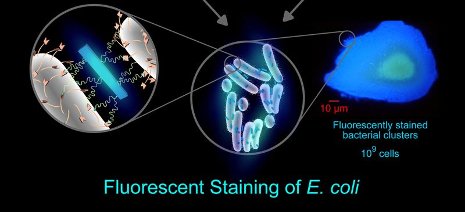Beautiful Bugs in Blue: The Making of Luminous Bacteria

A team of Michigan Technological University researchers led by Associate Professor of Chemistry Haiying Liu has discovered how to make a strain of E. coli glow under fluorescent light. The technique could eventually be used to track down all sorts of pathogens and even help in the fight against breast cancer.
E. coli bacteria are naturally found in animal intestines and are usually harmless. But when virulent strains contaminate food, like spinach or peanuts, they can cause serious illness and even death.
The researchers' trick takes advantage of E. coli's affinity for the sugar mannose. Liu's team attached mannose molecules to specially engineered fluorescent polymers and stirred them into a container of water swimming with E. coli. Microscopic hairs on the bacteria, called pili, hooked onto the mannose molecules like Velcro, effectively coating the bacteria with the polymers.
Then the researchers shined white light onto E. coli colonies growing in the solution. The bugs lit up like blue fireflies. "They became very colorful and easy to see under a microscope," said Liu.
The technique could be adapted to identify a wide array of pathogens by mixing and matching from a library of different sugars and polymers that fluoresce different colors under different frequencies of light. If blue means E. coli, fuchsia could one day mean influenza.
With funding from a Small Business Innovation Research grant from the National Institutes of Health, Liu is adapting the technique to combat breast cancer. Instead of mannose, he plans to link the fluorescent polymers to a peptide that homes in on cancer cells.
Once introduced to the vascular system, the polymers would travel through the body and stick to tumor cells. Then, illuminated by a type of infrared light that shines through human tissue, the polymers would glow, providing a beacon to pinpoint the location of the malignant cells.
The technique would allow surgeons to easily identify and remove malignant cells while minimizing damage to healthy tissue.
The team's work using polymers to detect E. coli was partially supported by the US Department of Agriculture and has been published in Chemistry--A European Journal. It is available at www3.interscience.wiley.com/journal/121637775/abstract .
The article, "Highly Water-Soluble Fluorescent Conjugated Fluorene-Based Glycopolymers with Poly(ethylene glycol) Tethered Spacers for Sensitive Detection of Escherichia coli, " is coauthored by Liu, postdoctoral associate Cuihua Xue, graduate students Singaravelu Velayudham and Steve Johnson, undergraduates Adrian Smith and Wilbel Brewer and Professor Pushpalatha Murthy, all of Michigan Tech's chemistry department; and graduate student Ratul Saha and Professor Susan T. Bagley of the biological sciences department.
NOTE: The illustration at left was provided by Susan Hill. Haiying Liu provided the photograph of the three E. coli bacteria fluorescing under a microscope.
Michigan Technological University is an R1 public research university founded in 1885 in Houghton, and is home to nearly 7,500 students from more than 60 countries around the world. Consistently ranked among the best universities in the country for return on investment, Michigan's flagship technological university offers more than 185 undergraduate and graduate degree programs in science and technology, engineering, computing, forestry, business, health professions, humanities, mathematics, social sciences, and the arts. The rural campus is situated just miles from Lake Superior in Michigan's Upper Peninsula, offering year-round opportunities for outdoor adventure.




Comments